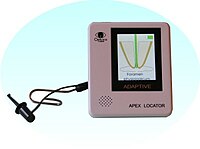
Photo from wikipedia
Aims and Background: The aim of this study was to evaluate the accuracy of the electronic actual length in detecting artificial perforations of the root canal in the presence of… Click to show full abstract
Aims and Background: The aim of this study was to evaluate the accuracy of the electronic actual length in detecting artificial perforations of the root canal in the presence of saline solution (NaCl, (Eczacibasi, Istanbul, Turkey), chlorhexidine [CHX (Werax, Tunadent, Izmir, Turkey)], QMix (Dentsply Tulsa, Maillefer, Ballaigues, Switzerland), and MTAD (Dentsply, Tulsa Dental, Tulsa, OK, USA). Materials and Methods: The root canals of 25 single-rooted extracted human teeth were perforated artificially in the middle section of the root. The actual lengths up to the perforation site were measured and then, the teeth were embedded in an alginate mold. Electronic measurements of the perforations were obtained by an electronic apex locator according to the manufacturers' recommendations under dry conditions and in the presence of NaCl, CHX, MTAD, and QMix using a #20 K-file. Each canal was irrigated with distilled water and then dried with paper points between the measurements. Statistical analyses were performed using the Friedman test and Spearman Rank correlation coefficient to assess the correlations between the measurement methods. Results: Highest correlation between the actual length and the electronic measurement was observed under dry conditions and NaCl solution (r: 0.932, r: 0.940 respectively), and the least correlation was observed with MTAD solution (r: 0.697) using statistical analysis. Moreover, the accuracy of the electronic apex locator with different irrigation solutions was statistically different from each other (P = 0.001). Conclusion: The most accurate electronic measurements of artificial perforation were obtained under dry conditions or with NaCl.
Journal Title: Nigerian Journal of Clinical Practice
Year Published: 2022
Link to full text (if available)
Share on Social Media: Sign Up to like & get
recommendations!